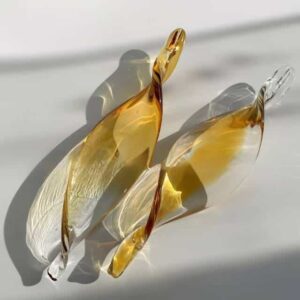Breathing Life into Glass: The Mesmerizing World of Hand-Blown Creations
Published on 2023年 9月 12日 by iartglass

Introduction
Glass has been a companion to human civilization for millennia, capturing our admiration and holding a deep-seated value in both function and aesthetics.
A Brief History of Hand-Blown Glass
Originating over 2,000 years ago in regions around Mesopotamia and Egypt, hand-blown glass artistry was a craft shrouded in mystique. The ancient Romans, particularly, took to this art form and popularized it across their vast empire. With its shimmering elegance and fluid forms, it’s not difficult to see why civilizations throughout history were enchanted by these molten masterpieces.
Some landmark moments in hand-blown glass history include:
- The establishment of Venice’s glass-making district in Murano during the 13th century.
- The introduction of lead glass in 1674, giving birth to what many know today as “crystal.”
- Modern explorations into abstract forms and vibrant colors during the 20th century.
Setting the Stage for the Artistry Involved
In today’s world, where machine-manufactured items reign supreme, the timeless appeal of hand-blown glass endures. Every piece, shaped by human hands, breath, and raw emotion, stands as a testament to the union of craft and creativity. Diving into the heart of this artistry, one brand in particular shines brightly: Siga Art Glass. Renowned for its bespoke pieces and unparalleled craftsmanship, Siga Art Glass invites you on a mesmerizing journey of color, form, and fluidity.
The Intricacies of Hand-Blown Glass
The realm of glass artistry is vast, with myriad techniques and styles. Yet, within this world, the art of hand-blown glass occupies a special place.
The Fundamental Difference Between Hand-Blown and Machine-Made Glass

It’s clear that while machine-made glass serves its purpose in function and affordability, hand-blown glass offers an intimate dance of art and emotion that’s unparalleled.
Highlighting the Uniqueness of Each Hand-Blown Piece
Every swirl of color, every bubble, and every nuanced shape makes each piece of hand-blown glass a unique work of art. While some might see a bubble as an imperfection, in the world of hand-blown glass, it’s a signature of authenticity. These characteristics, brought to life through intense heat and the artist’s vision, ensure that no two pieces are identical.
Whether it’s a vase that captures the movement of the ocean or a lamp that seems to encapsulate a galaxy, the journey from molten to marvelous is what makes each creation truly one of a kind.
Siga Art Glass: A Name Synonymous with Excellence
In the intricate world of hand-blown glass, some names rise above the rest through sheer skill, innovation, and dedication. One such name that has left an indelible mark is Siga Art Glass.
A Quick Introduction to Siga Art Glass
Founded on the principles of innovation and creativity, Siga Art Glass embodies the spirit of artisanal craftsmanship. Their atelier is not just a place where glass is shaped; it’s where raw materials are transformed into stories, where visions turn into tangible beauty. Each creation, with its intricate designs and breathtaking hues, is a testament to their unwavering commitment to excellence.
Why It Stands Out in the World of Hand-Blown Glass
Several factors contribute to the distinction of Siga Art Glass:
- Artisanal Expertise: A team of master glassblowers, each with years of experience, breathes life into every piece.
- Custom Creations: The ability to transform a client’s vision into glass artistry sets them apart.
- Eco-conscious Production: Prioritizing sustainable practices, they ensure that beauty doesn’t come at the cost of our environment.
- Continual Innovation: They constantly explore new techniques, ensuring that glass unveils its fascinating journey from science to art with each piece.
The Process of Hand-Blowing Glass
Delving into the magical world of glassblowing, we witness an alchemical transformation from a molten blob to exquisite artistry.
From Molten to Masterpiece: The Stages of Glassblowing
- Gathering: The process starts by gathering molten glass at the end of a blowpipe.
- Shaping: Using tools and hand movements, the artisan shapes the initial blob.
- Inflating: Air is introduced into the blowpipe, causing the glass to expand.
- Forming: Tools and gravity assist in refining the shape and adding detailed designs.
- Annealing: The piece is slowly cooled in an annealing oven to relieve internal stresses.
- Finishing Touches: Once cooled, the piece may undergo further detailing, polishing, or the addition of other elements.
It’s this mesmerizing transformation from molten to marvelous that captivates every viewer.
The Importance of Temperature and Timing
Glassblowing is a dance of precision. The molten glass needs to be at the perfect temperature for shaping – too hot, and it’s unmanageable; too cold, and it becomes rigid. Timing is equally crucial. Every second counts, as delays can lead to imperfections or even the loss of a piece.
The Allure of Colors and Designs in the Process
The introduction of colors is an art in itself. Whether it’s swirling two colors to achieve a galaxy effect or adding metallic oxides to create iridescence, the choices made at this stage determine the piece’s final appearance. The ability to experiment and play with designs – from intricate patterns to abstract forms – is where the heart of the artist truly shines.
Challenges Faced by Glassblowers
While the end product is undeniably beautiful, the journey is rife with challenges.
The Role of Bubbles and Their Significance
Bubbles, often seen as imperfections in other forms of manufacturing, can be both a boon and a bane in glassblowing. Intentional bubbles can add character and depth to a piece, serving as a unique signature. However, unintentional ones, especially if too large or improperly placed, can compromise the structural integrity of the item.
This intriguing dance of air pockets within the glass is often seen as [the mystery of bubbles](https://iartglass.com/the
-intrigue-of-imperfection-unraveling-the-mystery-of-bubbles-in-hand-blown-glass/) in hand-blown creations.
The Unpredictability of the Molten Medium
Molten glass is unpredictable. Its behavior can vary based on numerous factors – the exact temperature, the humidity in the studio, even the slight differences in raw materials. This unpredictability demands an intuitive understanding from the glassblower, making each creation not just a work of skill but also one of instinct.
Care and Maintenance of Hand-Blown Glass
Hand-blown glass pieces are more than just decorative items; they’re treasures encapsulating hours of dedicated craftsmanship. As such, their care and maintenance should mirror the respect we have for the art form.
Cleaning Tips for Preserving the Luster and Integrity
- Gentle Cleansing: Always use a soft cloth dampened with warm water. Avoid abrasive materials or chemicals which can scratch or damage the glass.
- Specific Cleaners: While mild soap is generally safe, specialized glass cleaners can be beneficial for particularly stubborn grime or fingerprints.
- Drying: Pat dry with a lint-free cloth to prevent water spots.
- Avoid Extreme Temperatures: Never expose your glass piece to sudden temperature changes; this could cause cracks or breaks.
Regular cleaning is essential for preserving that newly-bought sparkle. For a comprehensive guide, check out our ultimate guide to cleaning and preserving hand-blown creations.
Proper Handling and Storage to Prevent Damage
- Safe Display: Ensure that your piece is displayed on a sturdy and level surface, away from high-traffic areas.
- Handling: Always handle with clean hands, preferably wearing cotton gloves to avoid transferring oils or dirt.
- Storage: If storing, wrap in soft padding and keep in a box, away from potential hazards.
Choosing the Perfect Hand-Blown Piece
Every hand-blown piece is unique, and selecting one that resonates with you is a deeply personal journey.
Factors to Consider: From Size to Design and Color
- Space & Location: Understand where the piece will reside. Consider dimensions and how it complements its surroundings.
- Design Preference: From abstract swirls to detailed patterns, identify what speaks to you.
- Color Palette: Does a vibrant hue draw you in, or are you more inclined towards subtle tones?
- Budget: Remember, you’re not just purchasing a decorative item but a piece of art.
Remember, each selection is more than a purchase; it’s an investment in artistry.
The Beauty Beyond the Glass: Emotional and Artistic Value
While the aesthetic beauty of hand-blown glass is undeniable, its true value lies deeper.
How Hand-Blown Glass Resonates on a Personal Level
Every swirl, every bubble, every hue is a testament to an artist’s dedication. Owning a piece means you’re a part of that narrative, a link in the chain of its history.
The Emotional Journey from Creation to Collection
It’s a dance of passion, from the artist’s first vision to the moment it captures your heart. The joy of discovering a piece, feeling its weight, and seeing its play of light can be profoundly moving.
Conclusion
The world of hand-blown glass is ever-evolving, a testament to human creativity and the pursuit of beauty. Each piece, with its story and artistry, beckons us to pause, appreciate, and immerse ourselves in its allure.
As we wrap up this exploration, we invite you to delve deeper, to discover more about this intricate art form, and perhaps, to find a piece that speaks to your soul, waiting to be a cherished part of your collection. After all, in every curve and color of hand-blown glass, there’s a story waiting to be told.




